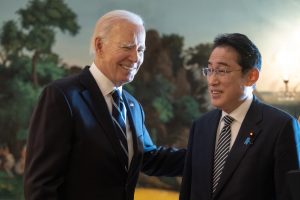The Diplomat author Mercy Kuo regularly engages subject-matter experts, policy practitioners, and strategic thinkers across the globe for their diverse insights into U.S. Asia policy. This conversation with Dr. Jeffrey Hornung – senior political scientist at RAND Corporation and adjunct professor at Georgetown University– is the 351st in “The Trans-Pacific View Insight Series.”
Identify the top three outcomes of the Japan-U.S. summit held in Washington, D.C., on January 13.
The summit wrapped up a week of high-level engagement by Japanese officials focusing on diplomatic and security issues. While the summit itself produced no big deliverables, it was notable in the sense that it showcased the tremendous alignment the U.S. and Japan have right now on all issues, both near and far to Japan.
Evaluate the substance and symbolism of talks between President Biden and Japanese Prime Minister Kishida.
I think there was more symbolism than substance, given that a lot of the substantiative items were covered by the 2+2 earlier in the week, but the symbolism itself is critically important. Showing that there is no daylight between the allies sends a powerful message to would-be adversaries.
Importantly, and I don’t think this is highlighted enough, it shows a much more forward-leaning Japan on traditional interests as well as issues geographically much further from Japan. The summit demonstrated the United States is fully supportive of Japan in these efforts.
How did the U.S. and Japan’s respective national security strategies factor into this meeting?
One of the objectives of the summit was for Prime Minister Kishida to explain Japan’s new National Security Strategy and related defense documents. A close read of Japan’s National Security Strategy shows that there is very close synergy in both countries’ strategic documents. Because of this alignment, it was not surprising to see the overlapping consensus on issues in their joint statement.
Explain the geopolitical relevance of this summit vis-à-vis China, Russia, and North Korea.
As I mentioned above, the symbolism of the meeting was critical to highlight the synergy in the allies’ approaches. The past month, topped off by the summit in Washington, showcased Japan’s forward leaning approach to security issues. The strategic documents by both countries showcase that their top security concerns in the Indo-Pacific region are China, Russia, and North Korea. The fact that they are aligned on this point is an important message that I am sure has been received loud and clear in Beijing, Moscow, and Pyongyang.
Assess the summit’s impact on advancing Japan-U.S. security cooperation in mitigating and managing regional risks in Northeast Asia.
More so than the summit itself, Japan’s new strategic documents that it released in December, followed by the 2+2 [on January 11], together help position the U.S.-Japan alliance to face the region’s security challenges in a more robust manner in all domains. No doubt there is a lot of work that awaits to implement these plans, but the summit demonstrates that the U.S. is fully supportive of Japan’s plans. The fact that Japan is willing to make these new changes, and the United States will cooperate with them in their efforts, will help position the allies to work together to mitigate and manage the risks they are facing in Northeast Asia.

































